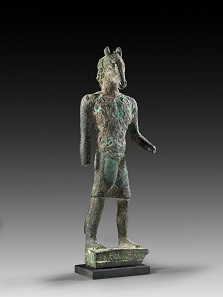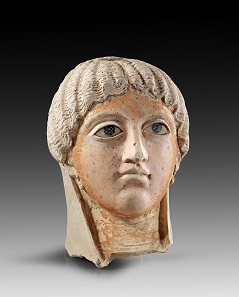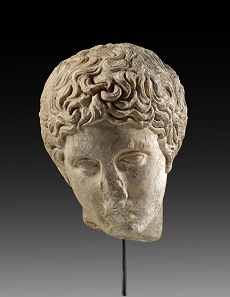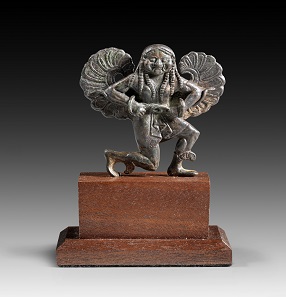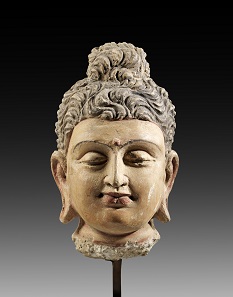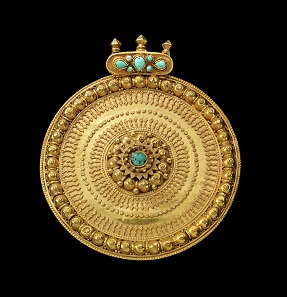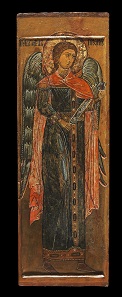13-12-2016 – 01-01-1970
Auction 243: Ancient Art
Excellent prices for ancient objects at Gorny & Mosch
A donkey-headed demon from Roman Egypt, an interesting but truly not that spectacular object with an outstanding provenance dating back as far as the late 1940s, really sprang a surprise when it became the most expensive lot of Gorny & Mosch Auction 243 comprising select ancient art.
Lot 23: Donkey-headed demon. Ca. 3rd cent. AD. H 27 cm. Hollow bronze cast. From K.M. Collection, Thuringia. Estimate: 3,000,- euros. Hammer price: 46,000,- euros.
On an estimate of 3,000 euros, the item with its hammer price of 46,000 euros brought more than 15 times the initial sum.
Lot 455: Tall ushabti. New Kingdom, ca. 1270-1080 BC. H 23 cm. Black basalt. From K.M. Collection, Thuringia. Estimate: 10,000,- euros. Hammer price: 20,000,- euros.
And this was by no means the only surprise. Most of all, the department of Egyptian art witnessed high prices for interesting objects. For example, a 23 cm high ushabti from the New Kingdom, made from black basalt and exhibiting an inscription quoting the 6th chapter of the Book of the Dead, rose from its estimate of 10,000 euros to a hammer price of 20,000 euros.
Lot 471: Mummy portrait. Roman Imperial times, 2nd-3rd cent. AD. H ca. 26 cm. Plaster stucco, painted. From A. Bade Collection, Bavaria. Estimate: 5,000,- euros. Hammer price: 12,500,- euros.
Dating from the 2nd to the 3rd century, a mummy portrait made of painted plaster stucco rose from an estimate of 5,000 euros to 12,500 euros. And a large ointment vessel with the cartouche of Thutmosis III from the 18th dynasty started at an estimate of 3,000 euros, to obtain a hammer price of 8,500 euros.
Lot 1: Polykleitan head of a youth. Hadrianic copy of a Greek bronze original dating from the second half of the 5th cent. BC. H 24 cm. From white, crystalline marble. From H.W. Collection, Hamburg. Estimate: 10,000,- euros. Hammer price: 17,000,- euros.
Objects from Classical antiquity of course brought rather respectable results as well, for example the two initial lots of the auction, each comprising a marble head of a male youth. The Hadrianic copy of a Greek bronze original by the famous sculptor Polykleitos rose from 10,000 euros to 17,000 euros while a Roman head of Hermes, following a model of late Classical times, rose from 8,000 euros to 16,000 euros.
Lot 21a: Gorgo Medusa. Greece, around 500 BC. H 7 cm. Solid bronze cast. From P.M.W. Collection, England. Estimate: 12,000,- euros. Hammer price: 22,000,- euros.
An impressive 22,000 euros was the final bid for a just 7 cm high Medusa a solid bronze cast made around 500 BC. Its Archaic appeal, as exhibited also in the early staters of Macedonian Neapolis, led some collectors to enter a bidding fight that started at 12,000 euros, only to finally arrive at almost twice this sum.
Lot 728: Head of Buddha. Gandhara, 2nd-3rd cent. AD. H 23.5 cm. Terracotta covered with colored plaster. From Kotalla Collection. Estimate: 2,500,- euros. Hammer price: 10,000,- euros.
The attractiveness of a slightly under life-size head of Buddha from Gandhara, made in the 2nd-3rd century AD, proved to be irresistible for another connoisseur. The appraisal of 2,500 euros was exceeded four times when it crossed the auction block for 10,000 euros.
Pre-Christmas shopping presumably was not the only contributing factor to some lots with ancient jewelry realizing impressively high prices. A Mycenaean necklace from the 13th-12th century BC rose from 1,600 euros to 6,000 euros, a silver Viking armring from the 10th century AD rose from 400 euros to 1,600 euros, an intact pair of late Roman openwork earrings made of gold with emeralds and garnets rose from 800 to 3,200 euros, and a Ptolemaic Harpocrates pendant, a miniature gold sculpture in the height of only 2.9 cm, rose from 600 euros to 2,000 euros.
The biggest surprise of all, though, was a late Hellenistic gold ring with a gemstone made of amethyst. The hoop is composed of three artistically entwined gazelles whose horns mount the gem. On an estimate of 3,000 euros, the object obtained the impressive result of 22,000 euros.
Gold pendant with turquoise. Ottoman, 14th-16th cent. AD. 118.82 g. Diameter 9.2 cm. From V.L. Collection, Rhineland. Estimate: 3,000,- euros. Hammer price: 11,000,- euros.
From a different civilization, yet the same collection came an Ottoman pendant dating from the 14th-15th century. Weighing 118.82 g, the gold pendant with a turquoise in the center exhibits an elaborate granules decoration. Its new owner willingly paid not the estimate of 3,000 euros but the hammer price amounting to 11,000 euros.
More than 110 lots containing ancient, for the most part Roman glass from different collections also formed part of Gorny & Mosch Auction 243. The prices were sound, but did not go over the top. They proved this to be an area where the collector can still make one or two discoveries. To mention only one example: a 1st cent. BC ribbed bowl produced either in the eastern Mediterranean region or in Italy. Having been estimated at 1,500 euros, the flat bowl, with its diameter of 16.2 cm, changed hands for 2,600 euros.
Lot 646: Icon: Archangel Michael. Russia, 17th century. H 96 cm, W 32.2 cm. From S.-K. Collection, Munich. Estimate: 1,000,- euros. Hammer price: 6,000,- euros.
Let’s conclude this review with some hammer prices of objects that formed part of the large collection of icons offered at Gorny & Mosch Auction 243. 5,500 euros was the result of the depiction of the two founders of the famous Solowetzkji Monastery (estimate: 2,500 euros) dated to ca. 1630 AD. Three Russian icons brought 6,000 euros: a St. George with silver oklad by the Muskovit silversmith M.F. Sokolow (estimate: 2,800 euros), a stylistically marvelous Archangel Michael originating from the 17th century (estimate: 1,000 euros), and the depiction of a Slavic church iconostasis with oklad from 1864, as it was used by the Old Believers, who did not have any priests, as church substitute in their homes (estimate: 2,500 euros).
The results can also be viewed on the internet.
Gorny & Mosch would be pleased to provide you with a printed list of results as well. Please contact Gorny & Mosch, Giessener Münzhandlung, Maximiliansplatz 20, D-80333 Munich, phone +49 / (0)89 / 24 22 643-0, telefax +49 / (0)89 / 22 85 513. The next auction of “Ancient Art” is scheduled for June 2017. Consignments will be taken in up to March 2017.





